Abstract
Markers of a heavy increase in training were examined in ten highly trained distance runners (mean(s.d.) age 29.8(1.7) years, maximal oxygen intake 65.3 ml kg-1 min-1, personal best 10-km time 31 min 4 s) who undertook a deliberate 38% increment of training over a 3-week period. Their running performance did not improve, and six of the ten subjects developed sustained fatigue, suggesting that training was excessive, although the full clinical picture of overtraining did not develop. The Profile of Mood States was the best single marker of disturbed function, indicating increased fatigue and decreased vigour. There were no useful changes of resting heart rate or perceived exertion during submaximal running, sleep was undisturbed, and there were no orthopaedic injuries. Two subjects developed rhinoviral infections following the heavy training, and a third complained of symptoms that were diagnosed 2 weeks later as exercise-induced asthma. The increase of serum cortisol normally induced by 30 min of submaximal exercise was no longer seen when the same acute exercise was performed after heavy training. Resting lymphocyte proliferation tended to increase in response to phytohaematoglutinin (PHA) and concanavalin A (Con A), the ratio of helper to suppressor cells (H/S) decreased, and pokeweed mitogen induced smaller increases in IgG and IgM synthesis. Whereas before heavy training, PHA-stimulated lymphocyte proliferation was unchanged by 30 min of acute submaximal exercise, after 3 weeks of heavy training the same bout of exercise caused an 18% suppression of proliferation. Likewise, heavy training brought about a decrease of T-lymphocytes in response to acute submaximal exercise, but an abolition of the acute exercise-induced decrease in the H/S ratio. The previously observed exercise-induced decrease of IgG synthesis did not occur when the same acute bout of exercise was performed after heavy training. We conclude that such minor and transient changes of immune function may possibly be a warning that training is becoming excessive, but they have only a limited significance for overall immune function.
Full text
PDF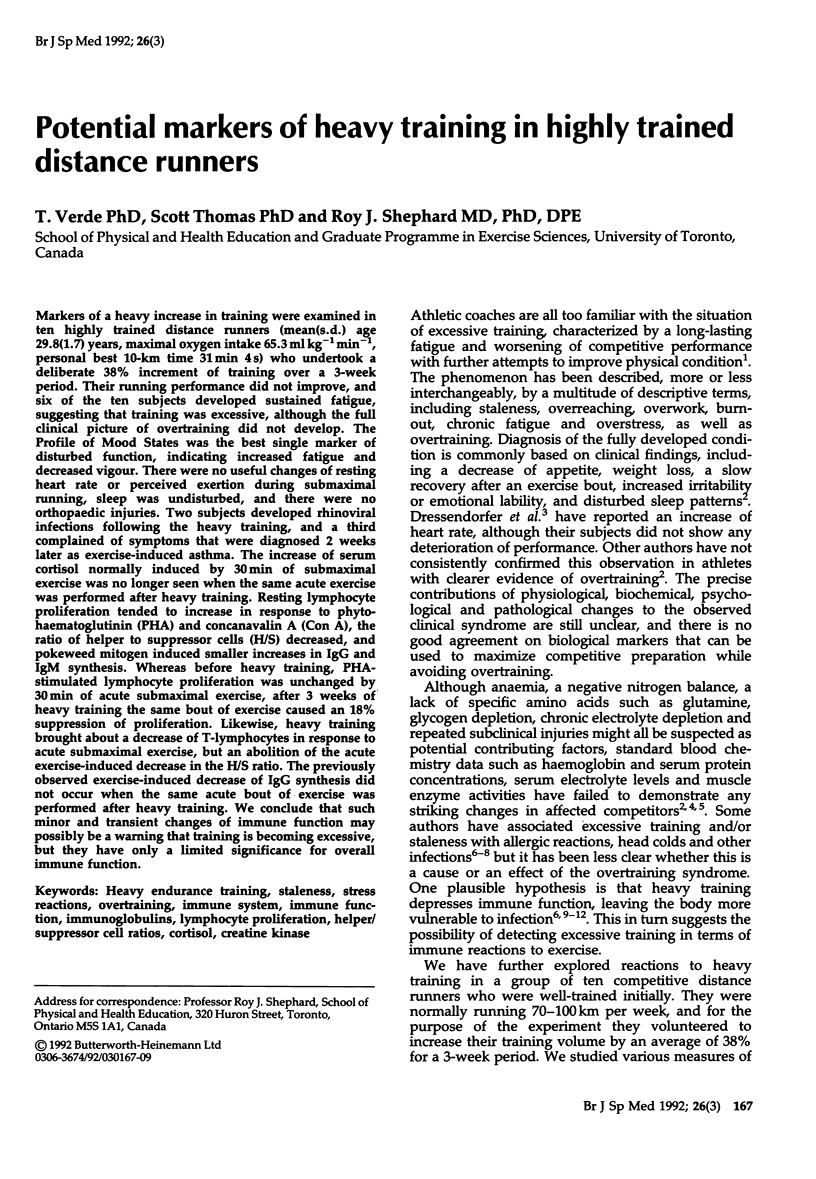

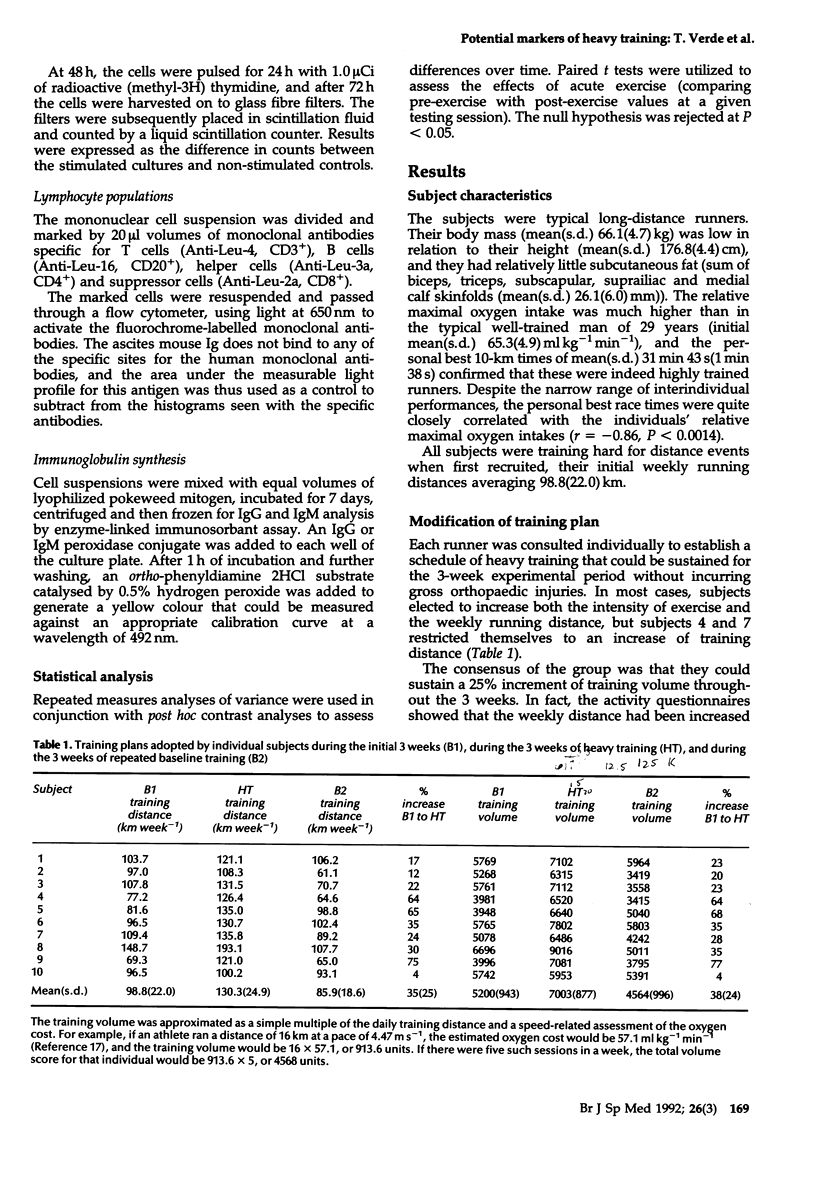
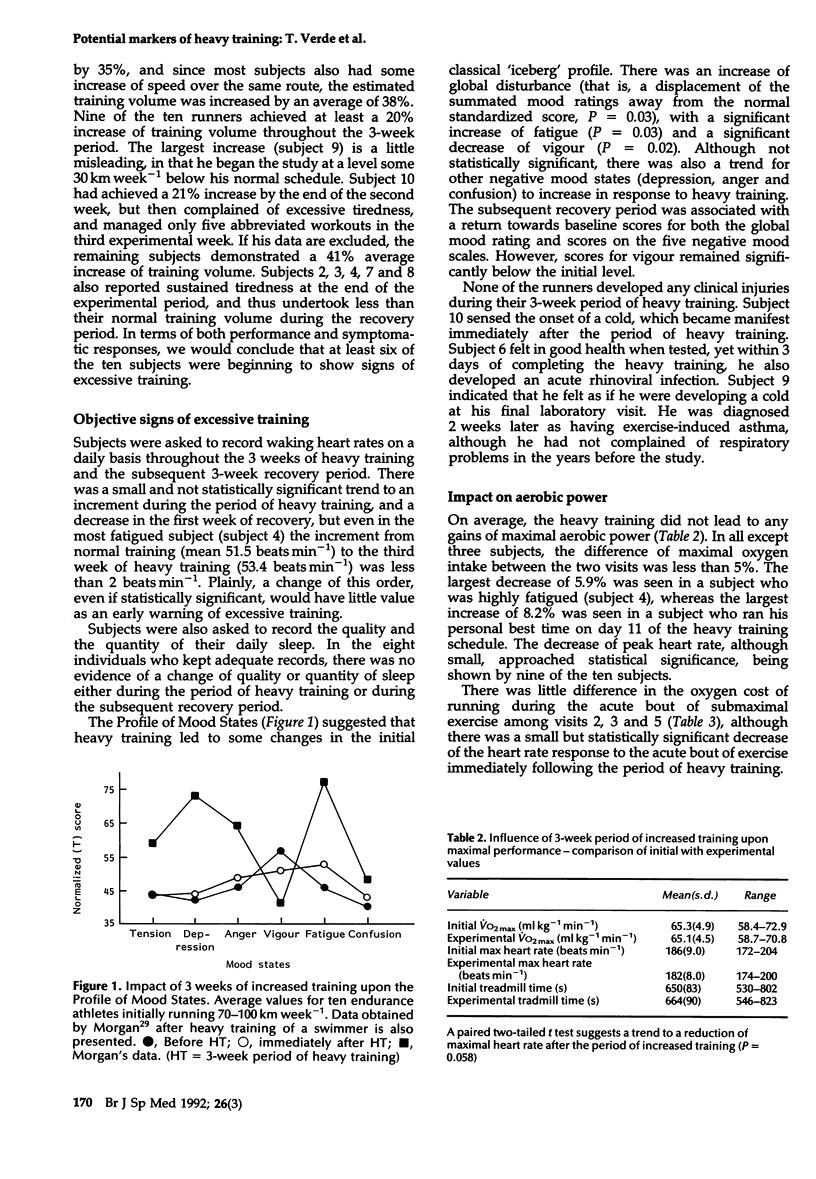
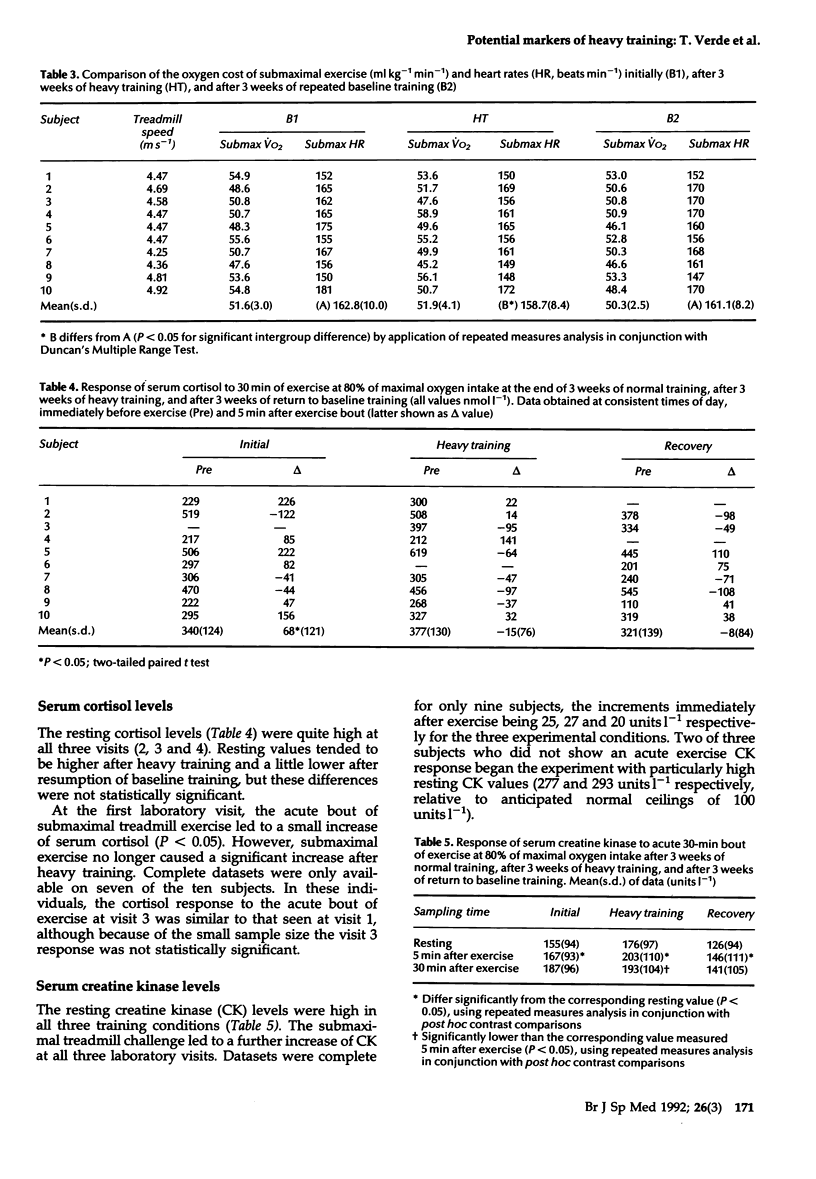
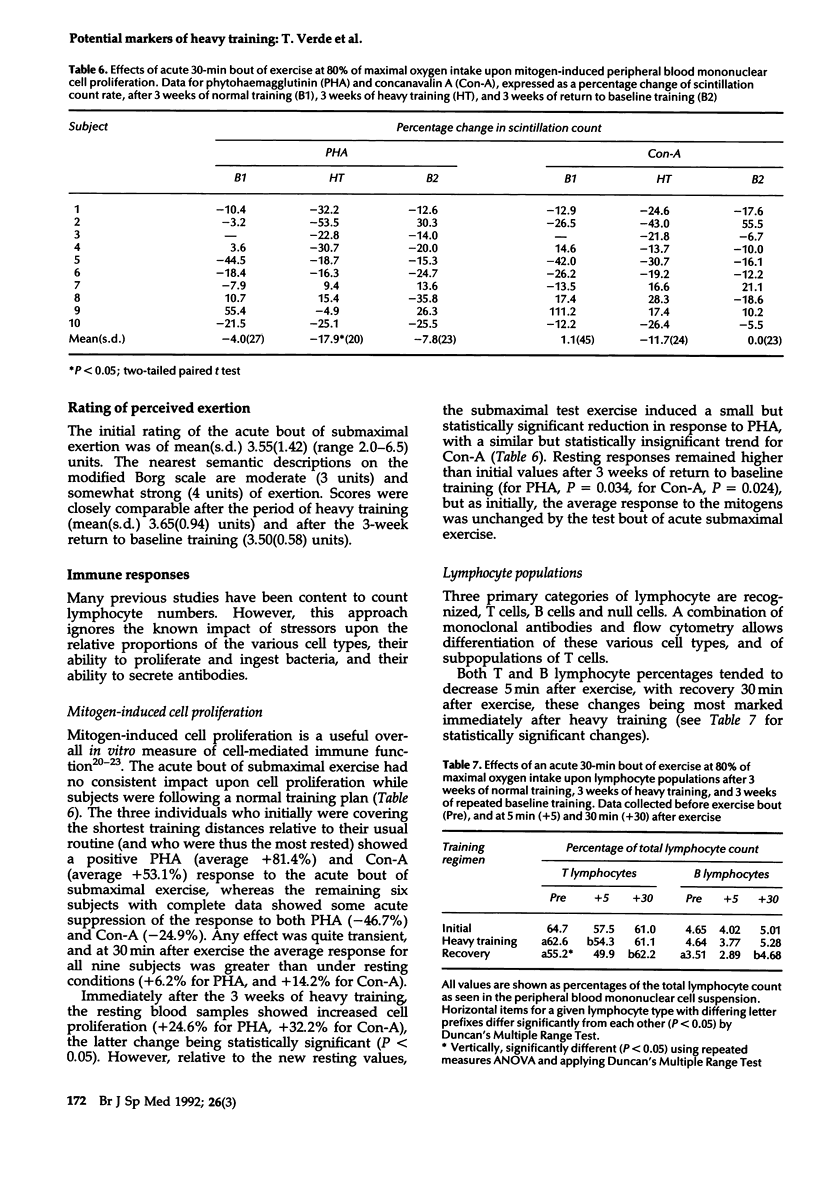

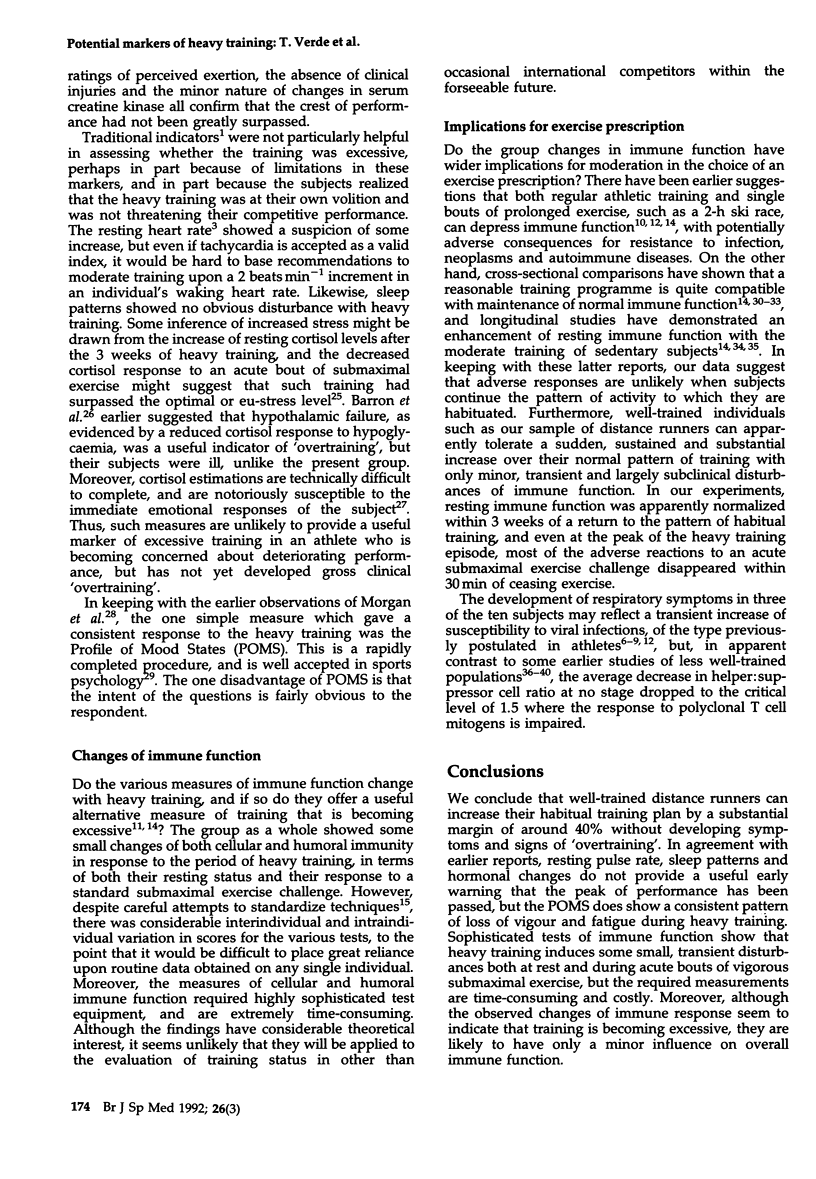
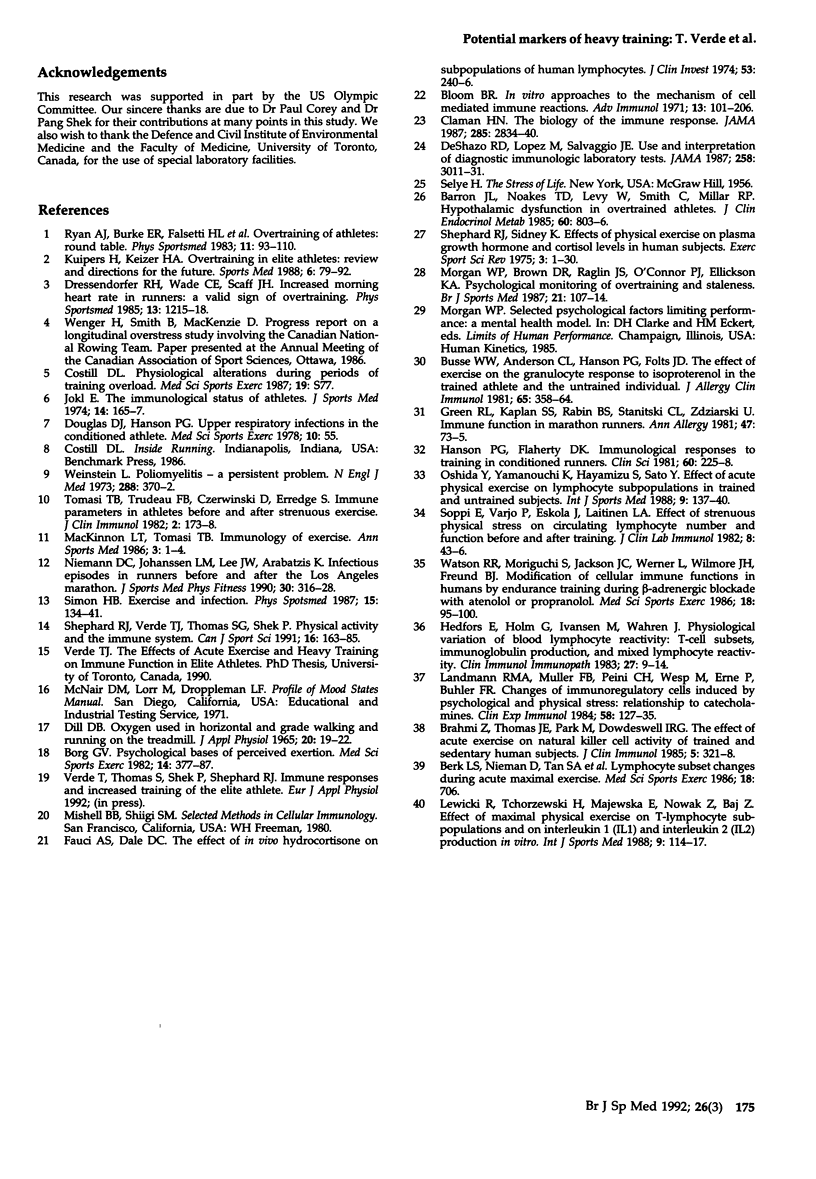
Selected References
These references are in PubMed. This may not be the complete list of references from this article.
- Barron J. L., Noakes T. D., Levy W., Smith C., Millar R. P. Hypothalamic dysfunction in overtrained athletes. J Clin Endocrinol Metab. 1985 Apr;60(4):803–806. doi: 10.1210/jcem-60-4-803. [DOI] [PubMed] [Google Scholar]
- Bloom B. R. In vitro approaches to the mechanism of cell-mediated immune reactions. Adv Immunol. 1971;13:101–208. doi: 10.1016/s0065-2776(08)60184-4. [DOI] [PubMed] [Google Scholar]
- Borg G. A. Psychophysical bases of perceived exertion. Med Sci Sports Exerc. 1982;14(5):377–381. [PubMed] [Google Scholar]
- Brahmi Z., Thomas J. E., Park M., Park M., Dowdeswell I. R. The effect of acute exercise on natural killer-cell activity of trained and sedentary human subjects. J Clin Immunol. 1985 Sep;5(5):321–328. doi: 10.1007/BF00918251. [DOI] [PubMed] [Google Scholar]
- Busse W. W., Anderson C. L., Hanson P. G., Folts J. D. The effect of exercise on the granulocyte response to isoproterenol in the trained athlete and unconditioned individual. J Allergy Clin Immunol. 1980 May;65(5):358–364. doi: 10.1016/0091-6749(80)90213-4. [DOI] [PubMed] [Google Scholar]
- Claman H. N. The biology of the immune response. JAMA. 1987 Nov 27;258(20):2834–2840. [PubMed] [Google Scholar]
- DILL D. B. OXYGEN USED IN HORIZONTAL AND GRADE WALKING AND RUNNING ON THE TREADMILL. J Appl Physiol. 1965 Jan;20:19–22. doi: 10.1152/jappl.1965.20.1.19. [DOI] [PubMed] [Google Scholar]
- Fauci A. S., Dale D. C. The effect of in vivo hydrocortisone on subpopulations of human lymphocytes. J Clin Invest. 1974 Jan;53(1):240–246. doi: 10.1172/JCI107544. [DOI] [PMC free article] [PubMed] [Google Scholar]
- Green R. L., Kaplan S. S., Rabin B. S., Stanitski C. L., Zdziarski U. Immune function in marathon runners. Ann Allergy. 1981 Aug;47(2):73–75. [PubMed] [Google Scholar]
- Hanson P. G., Flaherty D. K. Immunological responses to training in conditioned runners. Clin Sci (Lond) 1981 Feb;60(2):225–228. doi: 10.1042/cs0600225. [DOI] [PubMed] [Google Scholar]
- Hedfors E., Holm G., Ivansen M., Wahren J. Physiological variation of blood lymphocyte reactivity: T-cell subsets, immunoglobulin production, and mixed-lymphocyte reactivity. Clin Immunol Immunopathol. 1983 Apr;27(1):9–14. doi: 10.1016/0090-1229(83)90051-x. [DOI] [PubMed] [Google Scholar]
- Jokl E. The immunological status of athletes. J Sports Med Phys Fitness. 1974 Sep;14(3):165–167. [PubMed] [Google Scholar]
- Kuipers H., Keizer H. A. Overtraining in elite athletes. Review and directions for the future. Sports Med. 1988 Aug;6(2):79–92. doi: 10.2165/00007256-198806020-00003. [DOI] [PubMed] [Google Scholar]
- Landmann R. M., Müller F. B., Perini C., Wesp M., Erne P., Bühler F. R. Changes of immunoregulatory cells induced by psychological and physical stress: relationship to plasma catecholamines. Clin Exp Immunol. 1984 Oct;58(1):127–135. [PMC free article] [PubMed] [Google Scholar]
- Lewicki R., Tchórzewski H., Majewska E., Nowak Z., Baj Z. Effect of maximal physical exercise on T-lymphocyte subpopulations and on interleukin 1 (IL 1) and interleukin 2 (IL 2) production in vitro. Int J Sports Med. 1988 Apr;9(2):114–117. doi: 10.1055/s-2007-1024990. [DOI] [PubMed] [Google Scholar]
- Morgan W. P., Brown D. R., Raglin J. S., O'Connor P. J., Ellickson K. A. Psychological monitoring of overtraining and staleness. Br J Sports Med. 1987 Sep;21(3):107–114. doi: 10.1136/bjsm.21.3.107. [DOI] [PMC free article] [PubMed] [Google Scholar]
- Nieman D. C., Johanssen L. M., Lee J. W., Arabatzis K. Infectious episodes in runners before and after the Los Angeles Marathon. J Sports Med Phys Fitness. 1990 Sep;30(3):316–328. [PubMed] [Google Scholar]
- Oshida Y., Yamanouchi K., Hayamizu S., Sato Y. Effect of acute physical exercise on lymphocyte subpopulations in trained and untrained subjects. Int J Sports Med. 1988 Apr;9(2):137–140. doi: 10.1055/s-2007-1024995. [DOI] [PubMed] [Google Scholar]
- Shephard R. J. Meeting the blood flow needs of exercise. Can J Sport Sci. 1991 Sep;16(3):163–163. [PubMed] [Google Scholar]
- Shephard R. J., Sidney K. H. Effects of physical exercise on plasma growth hormone and cortisol levels in human subjects. Exerc Sport Sci Rev. 1975;3:1–30. [PubMed] [Google Scholar]
- Soppi E., Varjo P., Eskola J., Laitinen L. A. Effect of strenuous physical stress on circulating lymphocyte number and function before and after training. J Clin Lab Immunol. 1982 May;8(1):43–46. [PubMed] [Google Scholar]
- Tomasi T. B., Trudeau F. B., Czerwinski D., Erredge S. Immune parameters in athletes before and after strenuous exercise. J Clin Immunol. 1982 Jul;2(3):173–178. doi: 10.1007/BF00915219. [DOI] [PubMed] [Google Scholar]
- Watson R. R., Moriguchi S., Jackson J. C., Werner L., Wilmore J. H., Freund B. J. Modification of cellular immune functions in humans by endurance exercise training during beta-adrenergic blockade with atenolol or propranolol. Med Sci Sports Exerc. 1986 Feb;18(1):95–100. [PubMed] [Google Scholar]
- Weinstein L. Poliomyelitis--a persistent problem. N Engl J Med. 1973 Feb 15;288(7):370–372. doi: 10.1056/NEJM197302152880714. [DOI] [PubMed] [Google Scholar]
- deShazo R. D., Lopez M., Salvaggio J. E. Use and interpretation of diagnostic immunologic laboratory tests. JAMA. 1987 Nov 27;258(20):3011–3031. [PubMed] [Google Scholar]


